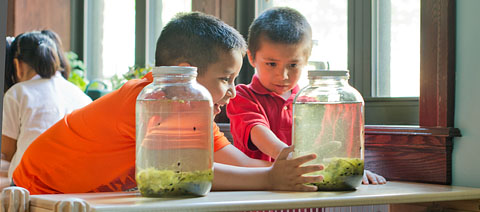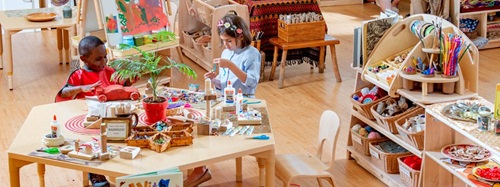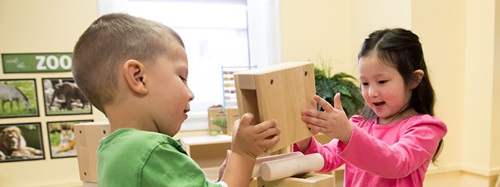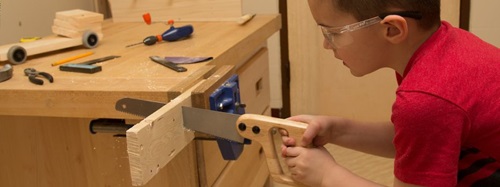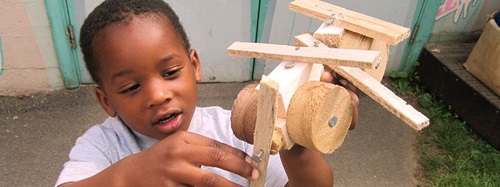Science is Wonder
| August 2015The best way to teach science to preschoolers is to inspire them to wonder. Let them be scientists. Let them come up with questions. Let them explore.
What’s in the Box?
In my book, All in One Day, the teacher, Walter, hands each child a box that is taped shut. There is something inside and each box has a small hole. The children need little encouragement to try to figure out what is inside. They immediately find some clues. They can hear that it sounds like metal. They can see the size of the box and infer that the object is smaller than the box. I imagine that some children would stick their fingers in the hole in the box and try to feel the object. Some would look inside although it turns out to be too dark to see anything.
At this point the children are using listening skills, as well as differentiating materials (metal, plastic, etc.). They are problem solving. What they are, in essence, are researchers. They have a question to be answered and they will come up with several hypotheses.They will test those hypotheses, and they and their “colleagues” will narrow down the possibilities.
Sooner or later, one of the researchers is going to think of tools that will help the investigation. I imagine someone will get a pair of scissors and try to cut the box. In the book, one of the researchers decides that a flashlight would help. As it turns out, Walter had flashlights ready, anticipating that someone would come up with the idea.
Science from a Box
Too often in Early Childhood programs, science comes out of a box. Each year children watch caterpillars in a butterfly tent make chrysalises and come out as butterflies. The activity is good, and it is quite dramatic. Most children see butterflies and are fascinated by them. Many children over the age of four could probably tell you that butterflies were once caterpillars. Certainly teachers can still have children ask questions and make predictions. Most children have read books about butterflies and know the basic story line, but a good teacher will help them focus on the details that can only be discovered by observation.
What’s missing from the butterfly activity is the power of the ordinary. Let’s face it, all insects have a larval stage and metamorphose into an adult. It would be just as easy for a class to watch mealworms change into darkling beetles, but it doesn’t happen as often.
Science is mostly about the things we see every day but don’t notice. Most of us probably couldn’t explain why the sky is blue or what part of the branch leaves grow on and what parts they don’t. And it’s OK that we don’t have the answers. What we need to do is help children ask those questions about the everyday things, and then help them figure out how to answer their questions. Science is about wonder.
Breaking Out of the Box
A teacher (or other adult) can help foster this sense of wonder by offering time and tools.
Children need to be in nature for long unstructured periods of time where they naturally will make discoveries. It often starts with collecting small objects: stones, nuts, leaves, dandelions. As children collect, they notice similarities and differences.
An adult (or older child) can help the child reflect on what they have discovered. The adult can ask open-ended question, taking the time to hear the child’s answers rather than provide answers. “Tell me about these.” “How could I find some?”
The adult can also introduce “wonder” questions. “I wonder if …” “I wonder what would happen if you …”
Seeing What They Can’t See
If children are going to be scientist, they also need tools. Tools can help children see things they can’t see otherwise. Magnifying glasses are often provided, but I have found that they don’t provide much that a child can’t see by looking closer. On the other hand, a portable stereo microscope is fairly inexpensive and can be brought outside. Unlike compound microscopes, which require specimens to be mounted on slides, stereo microscopes allow the specimen to be simply placed under the lens. Worms and insects can crawl under. Pinecones, leaves, or any object under four inches in width can fit and the lenses can be focused on different parts of the object. Children can often see patterns on wings and leaves invisible to the naked eye. For younger children who may have a hard time looking into the microscope, you can hold a camera to one of the eyepieces and children can look at the camera’s screen.
In my preschool classroom, one girl watched a worm move across the base of the microscope. She noticed the setae on the worm helped it move. After watching it, she held the worm and felt it tickle her hand. She realized she was feeling the setae. She had felt this before, but looking in the microscope helped her notice it.
Another way for them to “see what they can’t see” is to open up the object. Hammers, knives, and saws can be used by children over the age of three with adult supervision. Hammers can be used to crack nuts and other hard objects. Pumpkin carving knives can be used to open many firm vegetables. Depending on the size of the group and the abilities of the children, other knives could be used as well. An adult should hold the object unless it is big enough to stay still on its own. Saws can be used to open many other things. You need to clamp the object down so the children don’t have to hold the object while sawing. In general, preschoolers only pay attention to one thing at a time so they shouldn’t have to worry about steadying the object while cutting it.
Several years ago I asked my class how a marker works. There were several theories, some more realistic than others. Then I clamped the marker to a workbench, and helped the children saw the marker open. Even the kids who had predicted accurately were amazed to see the color-filled cylinder. I have done the same with golf balls, soccer balls and a guitar (all broken).
Many appliances or machines can be opened with screwdrivers. An adult should open it first to assess any risk of injury from sharp corners or moving parts. Adults may also find that there is very little for young children to see to understand how the machine works. While children can’t open up every appliance on a whim, they may look closer at machines they may have otherwise looked right past.
Giving children time and tools to explore the world around them allows them to be scientists. They are not just opening a walnut or a seedpod or a washing machine. They are opening a door to a new world. They are opening themselves up to wonder.
After all, science is wonder.

